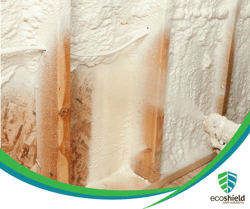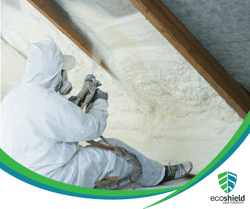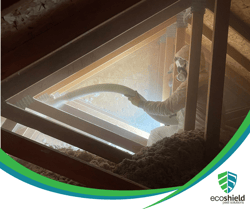 Rodents are notorious for gnawing through various materials in their quest for food, nesting spots, and shelter, and homeowners are often concerned about the durability of their insulation. While insulation plays a crucial role in keeping homes comfortable and energy-efficient, not all insulation types are equally resistant to these persistent pests. In this article, we’ll explore whether spray foam insulation is effective in deterring rodents or if they can chew through it as easily as other materials. We’ll cover the behaviors that drive rodents to chew, what makes certain insulation types vulnerable, and provide tips to help you protect your home from these unwelcome guests.
Rodents are notorious for gnawing through various materials in their quest for food, nesting spots, and shelter, and homeowners are often concerned about the durability of their insulation. While insulation plays a crucial role in keeping homes comfortable and energy-efficient, not all insulation types are equally resistant to these persistent pests. In this article, we’ll explore whether spray foam insulation is effective in deterring rodents or if they can chew through it as easily as other materials. We’ll cover the behaviors that drive rodents to chew, what makes certain insulation types vulnerable, and provide tips to help you protect your home from these unwelcome guests.
Why do rodents eat non-food items like insulation?
Rodents are infamous for chewing on non-food items, including insulation, wiring, wood, and even plastic. This behavior is primarily driven by the biology of their teeth. Rodents, including rats, mice, and squirrels, have front incisors that grow continuously throughout their lives. Without regular wear, these teeth would grow too long, making it difficult for them to eat properly. To keep their teeth at a manageable length, rodents instinctively gnaw on various objects in their environment, even if these items aren't edible or nutritious. Chewing on hard or fibrous materials like insulation provides the resistance needed to wear down their teeth and prevent them from overgrowing.
 Another reason rodents chew on insulation is to create and expand nesting spaces. When rodents find their way into a home, they often look for areas that are warm, quiet, and hidden from predators—qualities that attic and wall insulation often provide. By gnawing through insulation, rodents can make room to build nests where they can sleep, reproduce, and store food. Insulation materials, especially types like fiberglass, offer the perfect combination of warmth and softness, making them an attractive choice for nest-building.
Another reason rodents chew on insulation is to create and expand nesting spaces. When rodents find their way into a home, they often look for areas that are warm, quiet, and hidden from predators—qualities that attic and wall insulation often provide. By gnawing through insulation, rodents can make room to build nests where they can sleep, reproduce, and store food. Insulation materials, especially types like fiberglass, offer the perfect combination of warmth and softness, making them an attractive choice for nest-building.
Rodents are also known to explore their surroundings through taste and touch, as they constantly search for food sources. In their scavenging, they may chew through insulation in search of food hidden behind walls or in other inaccessible areas. When a rodent detects a scent on or around insulation, they’re likely to gnaw through it to investigate, sometimes leaving a trail of damage even if they don’t find anything edible. Even spray foam insulation, which is often marketed as rodent-resistant, may still attract their attention, especially if it is near food or water sources or if they detect a path to shelter.
 Lastly, rodents may chew on insulation simply out of curiosity or habit. In the wild, they constantly explore their environment, and chewing is a significant part of that process. When rodents encounter a new texture or material, they tend to nibble on it to see if it’s useful or can be broken down. This behavior becomes problematic when they enter human homes, where non-food items like insulation are plentiful. Unfortunately, this natural chewing habit can lead to significant structural damage and heat loss, causing homeowners headaches and costly repairs. Understanding why rodents are drawn to insulation can help you better prevent infestations and protect your home from these persistent pests.
Lastly, rodents may chew on insulation simply out of curiosity or habit. In the wild, they constantly explore their environment, and chewing is a significant part of that process. When rodents encounter a new texture or material, they tend to nibble on it to see if it’s useful or can be broken down. This behavior becomes problematic when they enter human homes, where non-food items like insulation are plentiful. Unfortunately, this natural chewing habit can lead to significant structural damage and heat loss, causing homeowners headaches and costly repairs. Understanding why rodents are drawn to insulation can help you better prevent infestations and protect your home from these persistent pests.
What kinds of insulation do rodents eat?
Rodents are highly persistent creatures with strong, ever-growing teeth that can chew through a wide range of materials, including some types of insulation. They don’t technically “eat” insulation but gnaw through it to create pathways, nest spaces, or gain access to other areas of a home. Each insulation type offers varying levels of resistance to rodents, so it's helpful to understand which are more vulnerable and which offer better protection.
 Fiberglass insulation, often recognizable by its pink or yellow batt form, is a common choice for homeowners. Unfortunately, fiberglass doesn’t hold up well against rodents. Mice and rats can chew through fiberglass easily and often use it as nesting material. The fluffy, soft texture of fiberglass batt insulation provides warmth and can be an inviting option for rodents looking to build nests, especially during colder months.
Fiberglass insulation, often recognizable by its pink or yellow batt form, is a common choice for homeowners. Unfortunately, fiberglass doesn’t hold up well against rodents. Mice and rats can chew through fiberglass easily and often use it as nesting material. The fluffy, soft texture of fiberglass batt insulation provides warmth and can be an inviting option for rodents looking to build nests, especially during colder months.
 Spray foam insulation, made of polyurethane, is another popular option for insulating hard-to-reach spaces. While it may provide a temporary deterrent, spray foam is not entirely rodent-proof. Determined rodents can gnaw through it, especially when they are motivated by the smell of food or warmth on the other side. However, spray foam is sometimes used in combination with other deterrent methods, like wire mesh, to help reduce rodent access, but it is not a foolproof solution on its own.
Spray foam insulation, made of polyurethane, is another popular option for insulating hard-to-reach spaces. While it may provide a temporary deterrent, spray foam is not entirely rodent-proof. Determined rodents can gnaw through it, especially when they are motivated by the smell of food or warmth on the other side. However, spray foam is sometimes used in combination with other deterrent methods, like wire mesh, to help reduce rodent access, but it is not a foolproof solution on its own.
 Cellulose insulation, made primarily from recycled paper treated with borate, tends to be more resistant to rodents. The borate treatment, in particular, acts as a natural deterrent, as it has properties that can be toxic to rodents if ingested. Cellulose doesn’t provide the same nesting material appeal as fiberglass, making it less attractive overall. While no insulation is entirely rodent-proof, cellulose is often considered a better option for homeowners looking to minimize the risk of rodent infestations in their insulation.
Cellulose insulation, made primarily from recycled paper treated with borate, tends to be more resistant to rodents. The borate treatment, in particular, acts as a natural deterrent, as it has properties that can be toxic to rodents if ingested. Cellulose doesn’t provide the same nesting material appeal as fiberglass, making it less attractive overall. While no insulation is entirely rodent-proof, cellulose is often considered a better option for homeowners looking to minimize the risk of rodent infestations in their insulation.
Why is spray foam insulation sometimes called “rodent proof”?
Spray foam insulation is sometimes touted as "rodent proof" because it forms a dense, hard layer that fills in cracks, gaps, and cavities where rodents might otherwise find entry. Unlike softer insulation types such as fiberglass or cellulose, spray foam insulation creates a tough barrier that can make it difficult for pests to penetrate at first glance. This reputation stems from its tight sealing properties, which effectively block drafts, moisture, and even sound, giving homeowners a sense of security that spray foam might also keep rodents at bay. However, despite its dense texture, the claim that spray foam insulation is rodent-proof is a common misconception.
 In reality, spray foam insulation is not immune to rodent damage. Rodents have strong, sharp teeth that continuously grow, and they’re highly motivated to chew through a variety of materials to maintain their teeth and gain access to nesting sites, food, and warmth. Even though spray foam insulation may be less inviting than softer materials, it does not provide an impenetrable barrier for a determined rodent. Mice, rats, and squirrels can gnaw through spray foam insulation if they sense an entry point or a hidden food source beyond it. Once they’ve chewed through, they may use the foam itself to create nests or simply push it aside to get where they need to go.
In reality, spray foam insulation is not immune to rodent damage. Rodents have strong, sharp teeth that continuously grow, and they’re highly motivated to chew through a variety of materials to maintain their teeth and gain access to nesting sites, food, and warmth. Even though spray foam insulation may be less inviting than softer materials, it does not provide an impenetrable barrier for a determined rodent. Mice, rats, and squirrels can gnaw through spray foam insulation if they sense an entry point or a hidden food source beyond it. Once they’ve chewed through, they may use the foam itself to create nests or simply push it aside to get where they need to go.
Homeowners should also understand that spray foam, while durable, lacks specific properties that repel rodents. Some types of insulation may incorporate chemical deterrents or materials that discourage pests, but standard spray foam insulation doesn’t offer this advantage. If rodents are already present in a space or nearby, they can still be enticed by warmth, food scents, or potential nesting areas within your home, regardless of the insulation type. Rodent-proofing a home involves a comprehensive approach that includes sealing potential entry points, setting traps, and maintaining good sanitation, rather than relying on insulation type alone.
In summary, spray foam insulation is not a "rodent-proof" solution. While it can add an extra layer of defense against drafts and gaps, it is not designed to prevent rodents from entering your home. For effective pest control, homeowners should consider a combination of rodent-proofing methods and consult professionals if they suspect an infestation.
What kind of insulation is best for deterring rodents?
 When it comes to rodent-proofing your home, choosing the right insulation can make a significant difference. Rodents are naturally inclined to chew through materials to build nests and create pathways for food access. While standard fiberglass, spray foam, and other common insulation types offer thermal efficiency, they typically lack the qualities necessary to repel pests. In fact, some types of insulation can even attract rodents by providing a warm, secluded place to nest. So, homeowners seeking a solution to deter rodents may want to consider pest-treated cellulose insulation, such as EcoShield's, which is designed specifically to resist these unwanted visitors.
When it comes to rodent-proofing your home, choosing the right insulation can make a significant difference. Rodents are naturally inclined to chew through materials to build nests and create pathways for food access. While standard fiberglass, spray foam, and other common insulation types offer thermal efficiency, they typically lack the qualities necessary to repel pests. In fact, some types of insulation can even attract rodents by providing a warm, secluded place to nest. So, homeowners seeking a solution to deter rodents may want to consider pest-treated cellulose insulation, such as EcoShield's, which is designed specifically to resist these unwanted visitors.
Pest-treated cellulose insulation is infused with borates, a natural pest deterrent. Borates are safe for humans but effectively repel insects and rodents by disrupting their digestive and nervous systems, making the insulation unappealing and unsafe for them to chew or nest in. This type of insulation provides a long-lasting solution for preventing pest infestations without compromising your home’s energy efficiency. Unlike spray foam or fiberglass, pest-treated cellulose acts as a physical and chemical barrier against pests, which means rodents are much less likely to chew through it and set up residence within your walls or attic.
 Beyond pest resistance, EcoShield’s cellulose insulation also offers additional benefits for your home. Made from recycled paper products, cellulose insulation is eco-friendly, helping reduce waste and lower energy bills by effectively sealing gaps and retaining heat. Its dense structure makes it effective at filling hard-to-reach spaces, minimizing air leaks, and adding a layer of soundproofing. These qualities make cellulose a top choice for energy efficiency and home comfort, alongside its pest-deterrent properties.
Beyond pest resistance, EcoShield’s cellulose insulation also offers additional benefits for your home. Made from recycled paper products, cellulose insulation is eco-friendly, helping reduce waste and lower energy bills by effectively sealing gaps and retaining heat. Its dense structure makes it effective at filling hard-to-reach spaces, minimizing air leaks, and adding a layer of soundproofing. These qualities make cellulose a top choice for energy efficiency and home comfort, alongside its pest-deterrent properties.
Overall, pest-treated cellulose insulation like EcoShield provides a well-rounded solution for homeowners concerned about rodents. By combining effective insulation properties with rodent deterrence, it can protect your home from unwanted pests while helping maintain a comfortable living environment year-round. Whether you're building a new home or updating your insulation, investing in pest-treated cellulose is a smart choice for lasting protection.